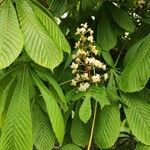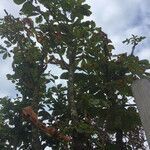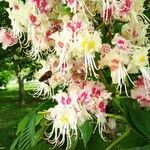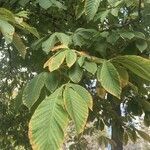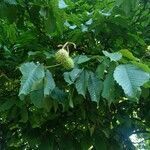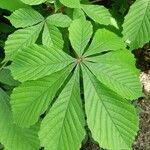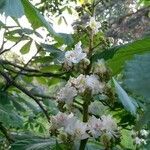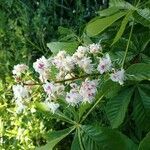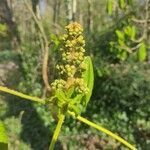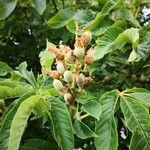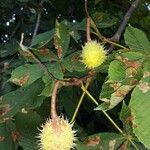Tree 10-15-(c. 25) m tall. Twigs stout, glabrous with prominent lf scars and large reddish brown, very viscid buds. Leaflets 5-7, sessile; central leaflets mostly 15-35 × 6-14 cm (basal leaflets smaller), obovate, somewhat brown-floccose below when young, later almost glabrous except for axillary tufts of hair beneath, irregularly crenate-serrate; base attenuate; apex cuspidate. Panicles to c. 30 cm high, broad-cylindric; peduncles and pedicels glabrous or hairy. Calyx 4-6 mm long, puberulent inside, scarious. Petals 1-1.7 cm long including narrow claw; limb ± broad-oblong, white with yellow to red spot near base, very undulate and recurved. Filaments slender, curving downwards, hairy. Capsule to 6 cm diam., subglobose, echinate. Seeds 1-2, 3-5 cm diam., usually ± subglobose, often somewhat asymmetric, dark shining brown with prominent, elongated, white hilum.
A rounded spreading deciduous tree. It grows to 25-30 m high and spreads to 5-20 m wide. The stem is erect. The bark is smooth and grey when young but becomes cracked and scaly with age. The leaves are like the fingers on a hand with 5-7 leaflets. The leaves are 30 cm long. The leaflets are wedge shaped and broadest towards the outer edge. There are fine teeth around the edge. The leaves have long leaf stalks. The flowers are white with yellow and in clusters 30 cm tall. They occur at the ends of branches. They have a sweet honey like perfume. The fruit is a spiny green chestnut capsule. Inside there is a brown nut with a shiny skin. It has 1-2 glossy brown seeds inside. The seeds are 5 cm across.
Tree to 25 m; winter-buds glutinous; lfls commonly 7(9), wedge-obovate, 1–2.5 dm, abruptly acute, irregularly serrate or biserrate, pubescent beneath when young, later glabrous; infls many-fld, ovoid-conic, 2–3 dm; cal 5–7 mm; upper and lateral pet with white rotund blade marked with red or yellow at the cordate base, on slender claws; fifth petal obovate, tapering to a broad claw, or wanting; fr echinate, 5 cm thick; 2n=40. Native of se. Europe and adj. Asia, occasionally escaped from cult. in our range. May.
